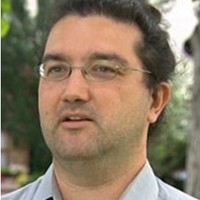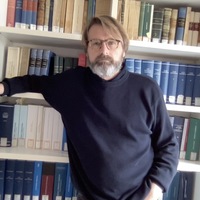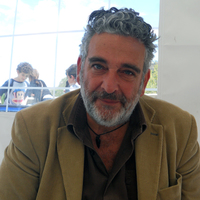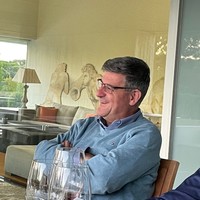
Francesco Genchi
Francesco Genchi, born in Bari (Italy) on July 9th 1977, obtained his Ph.D from the University of Bologna in 2012, and recently a research fellow from University La Sapienza of Rome. He is a professional archaeologist specialized in stratigraphic excavation and digital documentation techniques, as well as in archaeological survey and landscape mapping.
Genchi participated in excavations at Ras al-Hadd HD6, Ras al-Jinz RJ2 and was field-director for the Ministry of Heritage and Culture in rescue excavation for setting an oper-air archaeological park at Ras al Hamra in the Capital Area of Muscat. More recently, he directed field works for the Ministry of Heritage and Culture at the Early Iron Age metallurgical site of Uqdat Al-Bakra/As-Safah in the estearn Rub al-Khali and the collective graves LCG1 and LCG2 at Daba in the Musandam Governorate, as well as the Neolithic site HD2 at Ras al-Hadd. He directed also excavations and documentation projects along Segment 2 of the Batinah Expressway near Rustaq and conducted an intensive archaeological survey in the area of the Duqm Special Economic Zone Authority (SEZAD). He is presently director of the Italian Archaeological Project to Daba.
Outside Oman, he worked extensively in Italy, as well as in Eritrea, Dominican Republic, Pakistan, Turkmenistan, Uzbekistan, Kazakhstan, Morocco, Tunisia, India, Indonesia.
Genchi participated in excavations at Ras al-Hadd HD6, Ras al-Jinz RJ2 and was field-director for the Ministry of Heritage and Culture in rescue excavation for setting an oper-air archaeological park at Ras al Hamra in the Capital Area of Muscat. More recently, he directed field works for the Ministry of Heritage and Culture at the Early Iron Age metallurgical site of Uqdat Al-Bakra/As-Safah in the estearn Rub al-Khali and the collective graves LCG1 and LCG2 at Daba in the Musandam Governorate, as well as the Neolithic site HD2 at Ras al-Hadd. He directed also excavations and documentation projects along Segment 2 of the Batinah Expressway near Rustaq and conducted an intensive archaeological survey in the area of the Duqm Special Economic Zone Authority (SEZAD). He is presently director of the Italian Archaeological Project to Daba.
Outside Oman, he worked extensively in Italy, as well as in Eritrea, Dominican Republic, Pakistan, Turkmenistan, Uzbekistan, Kazakhstan, Morocco, Tunisia, India, Indonesia.
less
Related Authors
Armando Marques-Guedes
UNL - New University of Lisbon
Vajk Szeverényi
Déri Múzeum, Debrecen
Mauro Grondona
University of Genova
Derek H Alderman
University of Tennessee Knoxville
Ian G Baird
University of Wisconsin-Madison
Lorenzo Nigro
Università degli Studi "La Sapienza" di Roma
Ilia Palaguta
Saint-Petersburg Stieglitz State Academy of Art and Design
Enrico Giannitrapani
Arkeos
Rafael Domingo Osle
University of Navarra
John Agnew
University of California, Los Angeles










Uploads
Papers by Francesco Genchi
heterogeneity. At least 7% of historical individuals carry ancestry uncommon in the region where they were sampled, some indicating cross-Mediterranean
contacts. Despite this high level of mobility, overall population structure across western Eurasia is relatively stable through the historical period up to the present, mirroring geography. We show that, under standard population genetics models with local panmixia, the observed level of dispersal would lead to a collapse of population structure. Persistent population structure thus suggests a lower effective migration rate than indicated by the observed dispersal. We hypothesize that this phenomenon can be explained by extensive
transient dispersal arising from drastically improved transportation networks and the Roman
Empire’s mobilization of people for trade, labor, and military. This work highlights the utility of
ancient DNA in elucidating finer scale human population dynamics in recent history.
heterogeneity. At least 7% of historical individuals carry ancestry uncommon in the region where they were sampled, some indicating cross-Mediterranean
contacts. Despite this high level of mobility, overall population structure across western Eurasia is relatively stable through the historical period up to the present, mirroring geography. We show that, under standard population genetics models with local panmixia, the observed level of dispersal would lead to a collapse of population structure. Persistent population structure thus suggests a lower effective migration rate than indicated by the observed dispersal. We hypothesize that this phenomenon can be explained by extensive
transient dispersal arising from drastically improved transportation networks and the Roman
Empire’s mobilization of people for trade, labor, and military. This work highlights the utility of
ancient DNA in elucidating finer scale human population dynamics in recent history.
The documentation of remains of the largest and most distinctive of living marine turtles, D. coriacea, at Ra’s al-Hamra and Ra’s al-Hadd, presented herein, provide detailed information that serves as the basis for future interpretations and discussions regarding incomplete, disarticulated remains from the Mid to Late Holocene, particularly in reference to taphonomic questions and diverse environmental conditions.
RH-6 is located about 600 m far from the nearby site of RH-5. The site was first investigated in the 80’s by P. Biagi, whose work outlined the main characteristics of its occupation. It is dated to the sixth and fifth millennia BCE and is one of the earliest sites known along the Eastern littoral of the Arabian Peninsula (ELA).
During of the two seasons of fieldwork, four main sectors were investigated. In Sector A, a well-structured settlement, includes postholes directly cut into the bedrock that delimit some oval huts, and two auxiliary structures respectively used for fish and shell processing. In Sector B, several graves were documented allowing new considerations about funerary practices. In Sector C, a thorough stratigraphic excavation was carried out in a 2 x 2 m test trench dug up to a depth of 1,75 m in order to document the whole sequence of occupation as well as in the northern part of the site with the Trench North.
The opportunity of conducting new excavations at the Ra’s al-Hamra Neolithic sites is of great importance for scientific research focused on the study of prehistoric fishermen populations that settled along the ELA, and for understanding their earliest mortuary practices and rituals.
The chipped stone industry is not very abundant and it is characterized by small-sized tools mainly employed for the production of ornaments or implements. On the other hand, the polished and ground stone industry is abundant and differentiated. It comprises, particularly, numerous net sinkers, hammers and anvils mainly employed for crushing shells. Others artifacts are files, pestles, multi-functional tools, polishing stones, cutting tools, adzes, grindstones, spherical stones, maybe an anchor and few undefined particular tools. These artifacts are made mainly of wadi pebbles, gabbro, peridotite, sandstone, limestone, quartzite and schist.
The polished and ground stone industries from both sites are very similar. It demonstrates the cultural continuity of these artefacts used by the inhabitants of Ra’s al-Hamra for making tools and ornaments. However, some differences can be noted. Indeed, in the earliest site there are tools that at RH-5 do not seem to have been used any more: grooved stones, net sinkers with pecked or continuous incision around the waistline, net sinkers with notches on the smaller axis, grooved discs, cutting tool, few adzes of which one completely polished and greater differentiation between multi-functional tools.
Food subsistence was mainly provided by fishing and gathering activities in the mouth of the Wadi Aday which drains the mangrove. Also terrestrial (small ruminants and dog) and marine mammals (dolphin) as well as reptiles (green and leatherback turtle) were also exploited.
Shells and fish remains represent the largest amount of ecofacts discovered at the site. The first are mostly constituted by Potamidae, Ostreidae, Arcidae, Pteridae and Strombidae families. The second indicates that available inshore habitats where exploited, including the mangrove swamp and nearby corals and that large pelagic species such as Scombridae and Carangidae families where particularly targeted.
The results presented here bring new data on coastal human adaptation during the Early/Middle Holocene along the southeastern shore of the Arabian Peninsula.
The text begins with an introduction from Sultan al-Bakri in which he explains the discovery from the point of view of the Ministry of Heritage and Culture, which sponsored the field-work. Clearly the true site toponym is ʿUqdat al-Bakrah, although the first archaeologists on the site incorrectly called it as-Saffah, al-Ṣafāʾ and other names, after an oil prospection camp 40 km away.
In the first chapter Gösta Hoffmann explains the geology of the area, in order to get an idea of the pre-requisites for placing the site here. Important is water and fuel availability.
Roman Garba tells the story of the discovery from first-hand experience. He also worked in the communications branch in the area prior to the find.
Francesco Genchi and Claudio Giardino present the documentation of the excavations and find recovery made a few weeks after the finds were first sited. These finds establish the site dating and character.
Paul Yule updates the chronology for south-east Arabian metal-finds for the age from 3000 to 300 BCE. A main hurdle is to identify heirloom pieces and update the find chronology.
Claudio Giardino and Giovanni Paternoster examine the metallic finds by means of energy dispersive X-Ray fluorescence (ED-XRF) and therewith characterise the chemical composition and technology available to the ancient metallurgists.
Their results correlate nicely with the inductively coupled plasma atomic emission spectroscopy of Julie Goy with which she analysed 65 artefacts.
Guillaume Gernez synthesises the results of the different studies based on his expertise in metallic weaponry. His independent opinion is designed as a final representation of the find and its cultural importance.
It was deemed essential to make an exhaustive catalogue study of the entire find inventory with the intention that it would not be necessary to document any of the finds again. At the end concordances order the finds first by catalogue and then by find number. Except for 1:1 scale photographs of arrow-heads, the finds are drawn 1:3 in scale.
pp. 480-7, ISBN 978-99969-3201-4